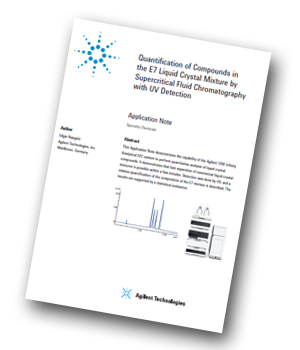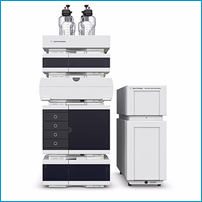Agilent Technologies has produced an application note demonstrating the capability of the Agilent 1260 Infinity Analytical SFC system to perform quantitative analysis of liquid crystal compounds.
 Abstract
Abstract
The application note demonstrates that fast separation of commercial liquid crystal mixtures is possible within a few minutes. Detection was done by UV, and a relative quantification of the composition of the E7 mixture is described. The results are supported by a statistical evaluation.
Introduction
Liquid crystal is a type of matter that has physical properties between the solid state and the liquid state. Liquid crystals can be obtained in thermotropic, lyotropic, and metallotripic phases. The liquid crystal compounds and mixtures are typically analysed by reversed-phase, high-performance liquid chromatography (HPLC) with UV or mass spectrometric (MS) detection. A typical reversed-phase HPLC separation of a mixture of liquid crystals takes about a one hour run time.
This application note demonstrates the separation of a mixture of liquid crystal compounds in a short run time by means of the Agilent 1260 Analytical SFC Solution. The quantification of all compounds is demonstrated by creation of the respective calibration curves after UV detection. The relative quantification of the content of a commercially available liquid crystal mixture is shown.
 Results and Discussion
Results and Discussion
From the individual stock solutions of the liquid crystal compounds 5CB, 7CB, 8OCB, and 5CT, a mixed stock solution was generated. This solution was used for the development of the SFC separation method. The single wavelength at 280 nm for the detection of all compounds was determined from individual spectra, where the response of all compounds was sufficient.
Conclusion
The baseline separation of a mixture of four liquid crystal compounds of technical importance is demonstrated in a fast, 2.25-minute run time. This fast run time is about a factor of 20-times faster than the typically used conventional RP-HPLC separations. The retention time RSDs are below 0.25 %, and the calibration curve linearity is better than 0.99990. The quantitative determination of the composition of a commercial E7 liquid crystal mixture is demonstrated.




